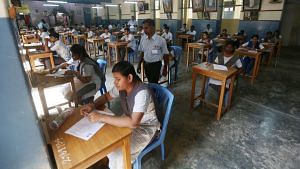
NOT JUST WRISTBANDS, LIFE IN TAMIL NADU SCHOOLS IS CASTE-CODED. PUNISHMENTS TO T-SHIRTS
Chennai: It was a day like any other. Students went about their day, making the most of their morning break; until an argument broke out between two groups comprising students from classes 10, 11 and 12. Within seconds, the argument escalated into a full-blown fight with students from both sides pelting stones at each other.
The fight at RC Government Higher Secondary school in Maruthakulam in Tamil Nadu’s Tirunelveli district on 1 July, it is learnt, was the culmination of ‘caste tension’ between residents of two villages inhabited by Mukkulathors (Thevars) and Nadars — both recognised by the state as subgroups within the Other Backward Classes (OBC) community.
“The fight was just an outcome of simmering caste tension between two groups of students from Ponnakudi and Mayaneri villages over who is superior. Casteist slurs are used against each other to prove one is more dominant than the other, and was the reason for the fight,” a Class 12 student who was injured in the clash told ThePrint.
Barely a fortnight earlier, a one-member committee led by former Madras High Court judge Justice K. Chandru (Retd) had submitted a report to the Tamil Nadu government recommending measures to curtail caste-based discrimination in educational institutions.
In its report, the committee called for disallowing students to wear coloured wristbands or any other article indicative of their caste. Besides removal of caste names from attendance registers, it also recommended formation of a ‘Social Justice Students Force’ and a quota for students from the Scheduled Castes (SC) community in Class 11 Science divisions.
Minister for School Education Anbil Mahesh said the state government will gradually begin implementation of the committee’s recommendations.
A closer look reveals that the prevalence of caste discrimination in schools in Tamil Nadu goes beyond merely wristbands or T-shirts.
Students and teachers ThePrint spoke to said caste lines are evident inside classrooms, as well as in various classroom-related chores. To add to that, there are also times when caste rivalry between different villages spills over, as was the case in Maruthakulam.
“Students wear coloured T-shirts inside their school uniform, which also refer to their caste identity. Sometimes, those T-shirts will also have the image of leaders of their communities,” said the headmaster of a government school in Madurai, who did not wish to be named.
Those ThePrint spoke to also pointed out that for school students the inclination to join a group comprising peers from the same caste is much stronger in rural parts of Tamil Nadu.
“In the village, we reside in Dalit colonies and they reside in the Upper Caste streets. So once we get into the school, this segregation remains the same; they don’t sit next to us or mingle with us,” said a Class 10 student of a state-run school in Tirunelveli district.
Asked for his take, writer and journalist Barathi Thambi told ThePrint that caste discrimination in schools cannot be eradicated unless society decides to do away with these faultlines first. “Caste in schools is just an extension of the caste system in the society. When they practise caste in their village, they cannot be friends with the same people in school. So it has to first start from their villages, from the society.”
Also Read: Violent clash erupts over temple entry for Dalits in Tamil Nadu ‘minutes after peace meeting’
‘Takes a second to grab their collars, but…’
Asked how caste discrimination plays out in schools, the Class 10 student quoted earlier said, “Our fellow students call us with caste slurs used in the village. We cannot talk back or fight inside the school since we cannot afford to switch to a different school if the fight erupts into a caste clash.”
She added that students tolerate these slurs for the sake of their future.
“It takes a fraction of a second to grab their collars, but the consequences will be worse for us than them. First, our parents will take us out of school and then we will be discriminated against and harassed back in our village as well,” she told ThePrint, adding that moving to another school is also not as easy since such practices are common in most nearby schools.
Similarly, in Kurayur village in Madurai district, Dalit students have alleged they were denied admission to a government school since a majority of students at the school come from a dominant caste group, said Kathir, director of Evidence, an NGO working to spread awareness about caste discrimination and ‘honour killings’.
“They say the atmosphere was not conducive to admitting Dalit students as there were high chances of dominant caste groups harassing Dalits. It’s been more than four decades now that a Dalit student from Kurayur village was admitted to the nearby government school,” said a Class 11 student whose daily commute to school is 10 kilometres each way.
Another boy from the Dalit community, a Class 10 student of a government school in Pollachi in Coimbatore district, added, “They don’t do it explicitly, but belonging to the SC community, we know why we are asked to do it.”
He shared how his friend, also from the Dalit community, was made to clean the school toilet as punishment for coming to school late. “It was not a usual thing. A lot of them come to school late, but such punishments are given only to us. We know it is because of our caste, but we cannot talk against them, since we have to finish schooling in the same school.”
A survey carried out by the Tamil Nadu Untouchability Eradication Front (TNUEF) in December last year sheds more light on discrimination in government, government-aided and private schools.
Of the 441 schools surveyed, it was found that Dalit students were made to clean toilets and subjected to caste-based discrimination in 15 schools in Thoothukudi, Tirunelveli, Sivaganga, Virudhunagar, Cuddalore, Ramanathapuram, Mayiladuthurai and Coimbatore districts.
The survey by TNUEF also found at least 28 types of discrimination in schools across the state.
It further highlighted that students display their caste identity in at least 11 forms including wearing a wristband or taking pride in their caste or the temple village festival.
Samuel Raj, state general secretary of the TNUEF, told ThePrint that caste discrimination in schools is prevalent in urban and rural areas. “One may not believe it is happening in Chennai. I don’t want to name the school. In one school in North Chennai, children were abused by their caste names and made to sit separately inside the classrooms,” he said.
‘Caste-coded’ waistband
One aspect of caste discrimination in schools in Tamil Nadu, as pointed out by both students and teachers, is the coloured wristband (denoting caste).
In April 2022, a 17-year-old Class 12 student from the Most Backward Class (MBC) community lost his life after suffering a head injury in a fight over a wristband in Tirunelveli district.
But this was not the first time such an incident was reported, said 29-year-old Karthik, who studied at a government college in Tirunelveli.
“In 2012, one student was killed inside the college hostel over a similar caste wristband fight. By that time, they tried to bring in a lot of restrictions, but nothing worked,” said Karthik, now a salesperson.
In 2019, a group of 2018-batch IAS officers who were then trainees had submitted a representation to the state government on how students were wearing articles or other identifiers that denoted their caste. They, too, had recommended disallowing such coloured wristbands in school.
On its part, the Department of School Education issued a circular to that effect, but the then AIADMK government was forced to withdraw it in the face of criticism from state leaders of its then ally BJP.
“For most IAS trainees then, it was something unusual and we thought it was a serious issue — if there is such a discriminatory atmosphere in schools, we couldn’t even imagine how these students would be in college and later in society. But prohibiting the wristbands seems a tough task,” said one IAS officer who was part of the group.
(Edited by Amrtansh Arora)
Also Read: Not Manusmriti, British—caste system in medieval Tamil Nadu solidified after Cholas fell
2024-07-05T05:20:28Z dg43tfdfdgfd
